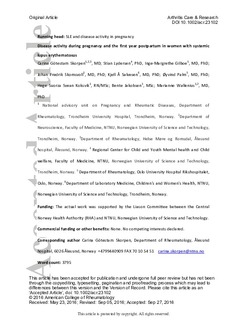| dc.contributor.author | Skorpen, Anna Carina G. | |
| dc.contributor.author | Lydersen, Stian | |
| dc.contributor.author | Gilboe, Inge-Margrethe | |
| dc.contributor.author | Skomsvoll, Johan Fredrik | |
| dc.contributor.author | Salvesen, Kjell Å | |
| dc.contributor.author | Palm, Øyvind | |
| dc.contributor.author | Koksvik, Hege | |
| dc.contributor.author | Jakobsen, Bente | |
| dc.contributor.author | Wallenius, Marianne | |
| dc.date.accessioned | 2018-03-20T08:08:46Z | |
| dc.date.available | 2018-03-20T08:08:46Z | |
| dc.date.created | 2017-09-08T13:27:31Z | |
| dc.date.issued | 2017 | |
| dc.identifier.citation | Arthritis care & research. 2017, 69 (8), 1201-1208. | nb_NO |
| dc.identifier.issn | 2151-4658 | |
| dc.identifier.uri | http://hdl.handle.net/11250/2491149 | |
| dc.description.abstract | Objective
Disease activity measured by validated methods has been sparsely examined during and after pregnancy in women with systemic lupus erythematosus (SLE). The aim of this study was to describe the longitudinal course of disease activity during pregnancy and the first year postpartum using the Lupus Activity Index in Pregnancy (LAI‐P).
Methods
RevNatus is a nationwide Norwegian prospective observational register including women diagnosed with inflammatory rheumatic diseases. LAI‐P is a modified version of the LAI, with a good ability to assess disease activity in pregnant women with SLE. These indexes were used to assess disease activity at 6 visits (in trimesters 1, 2, and 3, and at 6 weeks, 6 months, and 12 months postpartum). The longitudinal course of disease activity was analyzed using an ordinal logistic mixed model.
Results
A total of 757 visits (145 pregnancies) in women with SLE were included in the analysis. More than half (51.6%) of the disease activity scores indicated remission, and only 6.3% indicated moderate disease activity. The model showed a statistically significant and clinically relevant change in disease activity over time, and a higher disease activity 6 and 12 months postpartum compared to the third trimester and 6 weeks postpartum.
Conclusion
The majority of women had low or no disease activity at conception and during pregnancy, with higher disease activity at 6 and 12 months after delivery. This points to the importance of tight disease control not only before and during pregnancy but also in the first year postpartum. | nb_NO |
| dc.language.iso | eng | nb_NO |
| dc.publisher | Wiley | nb_NO |
| dc.title | Disease activity during pregnancy and the first year postpartum in women with systemic lupus erythematosus | nb_NO |
| dc.type | Journal article | nb_NO |
| dc.type | Peer reviewed | nb_NO |
| dc.description.version | acceptedVersion | nb_NO |
| dc.source.pagenumber | 1201-1208 | nb_NO |
| dc.source.volume | 69 | nb_NO |
| dc.source.journal | Arthritis care & research | nb_NO |
| dc.source.issue | 8 | nb_NO |
| dc.identifier.doi | 10.1002/acr.23102 | |
| dc.identifier.cristin | 1492131 | |
| dc.description.localcode | This is the peer reviewed version of the following article: [Disease Activity During Pregnancy and the First Year Postpartum in Women With Systemic Lupus Erythematosus], which has been published in final form at [https://onlinelibrary.wiley.com/doi/abs/10.1002/acr.23102]. This article may be used for non-commercial purposes in accordance with Wiley Terms and Conditions for Self-Archiving. | nb_NO |
| cristin.unitcode | 194,65,30,0 | |
| cristin.unitcode | 194,65,35,5 | |
| cristin.unitcode | 194,65,15,0 | |
| cristin.unitname | Institutt for nevromedisin og bevegelsesvitenskap | |
| cristin.unitname | RKBU Midt-Norge - Regionalt kunnskapssenter for barn og unge - psykisk helse og barnevern | |
| cristin.unitname | Institutt for klinisk og molekylær medisin | |
| cristin.ispublished | true | |
| cristin.fulltext | postprint | |
| cristin.qualitycode | 2 | |
